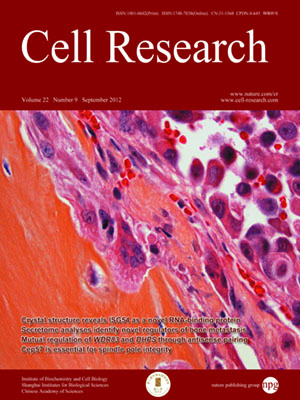
Volume 22, No 9, Sep 2012
ISSN: 1001-0602
EISSN: 1748-7838 2018
impact factor 17.848*
(Clarivate Analytics, 2019)
Volume 22 Issue 9, September 2012: 1390-1401
ORIGINAL ARTICLES
Cep57, a NEDD1-binding pericentriolar material component, is essential for spindle pole integrity
Qixi Wu1,*, Runsheng He1,*, Haining Zhou1, Albert CH Yu2, Bo Zhang1, Junlin Teng1 and Jianguo Chen1,3
1The State Key Laboratory of Biomembrane and Membrane Bioengineering and The Key Laboratory of Cell Proliferation and Differentiation of Ministry of Education, College of Life Sciences, Peking University, Beijing 100871, China
2Department of Neurobiology, Neuroscience Research Institute, School of Basic Medical Sciences, Peking University, Beijing 100191, China
3The Center for Theoretical Biology, Peking University, Beijing 100871, China
Correspondence: Junlin Teng, +86-10-62755786;(junlinteng@pku.edu.cn; chenjg@pku.edu.cn)
Formation of a bipolar spindle is indispensable for faithful chromosome segregation and cell division. Spindle integrity is largely dependent on the centrosome and the microtubule network. Centrosome protein Cep57 can bundle microtubules in mammalian cells. Its related protein (Cep57R) in Xenopus was characterized as a stabilization factor for microtubule-kinetochore attachment. Here we show that Cep57 is a pericentriolar material (PCM) component. Its interaction with NEDD1 is necessary for the centrosome localization of Cep57. Depletion of Cep57 leads to unaligned chromosomes and a multipolar spindle, which is induced by PCM fragmentation. In the absence of Cep57, centrosome microtubule array assembly activity is weakened, and the spindle length and microtubule density decrease. As a spindle microtubule-binding protein, Cep57 is also responsible for the proper organization of the spindle microtubule and localization of spindle pole focusing proteins. Collectively, these results suggest that Cep57, as a NEDD1-binding centrosome component, could function as a spindle pole- and microtubule-stabilizing factor for establishing robust spindle architecture.
Cell Research (2012) 22:1390-1401. doi:10.1038/cr.2012.61; published online 17 April 2012
FULL TEXT | PDF
Browse 2280


